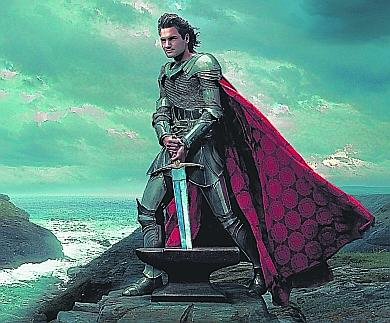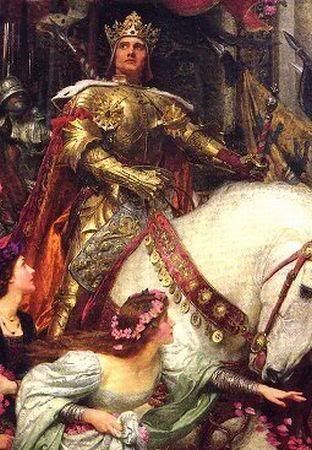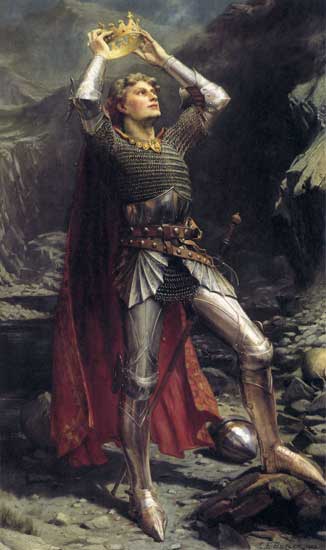
 King Arthur, who was he? was King Arthur a real person or a folk tale? Depending on the source he might be a late Roman, a Celt; a king, a general, or a guerilla warrior fighting the Saxons, the Romans, or even the Picts in the north of England.
King Arthur, who was he? was King Arthur a real person or a folk tale? Depending on the source he might be a late Roman, a Celt; a king, a general, or a guerilla warrior fighting the Saxons, the Romans, or even the Picts in the north of England.King Arthur may have fought a number of battles from Badon to his death perhaps at Camlann. The battles of King Arthur section details an extensive list of battles that may be attributed to him by Nennius. Nennius wrote around 800 AD, which would have been 200 years after the events that he was chronicling
The King Arthur of legend probably would have lived in post-Roman Britain. At a time when there was a power vacuum in Britain in the 5th and 6th centuries, the British had to defend themselves against several invasions. The most worrying of these invaders were the Angles and Saxons from northern Europe. It is during this fight for the control of Britain that the historical figure is thought to have lived.
Any battles King Arthur fought would probably have been against the Saxon invader, who had established themselves in the south east corner of England, and were expanding their territory both north and west. At the same time, their appear to have been Pict
 incursions into England from Scotland.
incursions into England from Scotland.The soldiers of this period were not "knight in shining armour" of romance. Their main weapon was a spear and not a of a sword, and you would have been unlikely to have seen them wearing a suit of armour. Battles were generally fought to gain land, and it was not until Badon, where a British defeat of the Saxons resulted in a generation of peace.
King Arthur as a knight, in armour, on horseback, is a creation of Chretien de Troyes , written around 1170 AD and purely romantic. In other words Camelot was not presented as an historical, but as a fictional location, using as inspiration that earlier writers had written, and he certainly was not presenting his work as original "scholarship". Chretien de Troyes is the man that created Camelot, Lancelot, and the Holy Grail.
In the era of King Arthur, life for the people was in barter-based economy, based on agriculture. There was only a small amount of trade with continental Europe, but items, such as clothing, were manufactured in Britain. The typical dress of native Britons was a tunic and trousers. Houses were of wood and thatch, with a central hall that was the
 social centre of the community.
social centre of the community.King Arthur almost certainly was idealised, a myth, a legend not a historical fact. The historical facts that might point to a "real" figure are few and far between, but it does not stop you admiring " the once and future king".
The Legend of King Arthur was made popular by Geoffrey of Monmouth in his History of the Kings of Britain written in 1135 AD. Chretien de Troyes and Malory later embellished Geoffrey of Monouth's story. These authors drew upon earlier histories including History of the Britons by Nennius, the Annales Cambriae, and the Complaining Book of Gildas, a Welsh monk from the 6th century, as well as local histories, poetry, Celtic mythology and traditions.
There are many versions of the Arthur legend. The following is a brief overview of some of the common elements of the legend. The bolded words are discussed below and go with the slides.
The Romans pulled their troops out of Britain in AD 410. With the loss of the Roman authority, local chieftans and kings competed for land. In 449 AD King Vortigern invited the Angles and Saxons to settle in Kent to help him to fight the Picts and the Scots. But
 the Angles and Saxons betrayed Vortigern at a peace council where they drew their knives and killed 460 British chiefs. The massacre was called the Night of the Long Knives and according to Geoffrey of Monmouth occurred at a monastery on the Salisbury Plain.
the Angles and Saxons betrayed Vortigern at a peace council where they drew their knives and killed 460 British chiefs. The massacre was called the Night of the Long Knives and according to Geoffrey of Monmouth occurred at a monastery on the Salisbury Plain.Ambrosius Aurelianus became King and consulted the wizard Merlin to help him select an appropriate monument to raise to the dead chieftains. Merlin suggested that the King's Ring from Mount Killarus in Ireland be dismantled and brought to England. The king's brother and Arthur's father, Uther Pendragon, leads an expedition of soldiers to bring the stones from Ireland to England. Merlin magically reconstructs the stones as Stonehenge on the Salisbury Plain around the burials of the dead British chieftains in the monastery cemetery.
Later, Uther Pendragon becomes King of England and at an Easter feast, falls in love with Igraine, the wife of the Duke of Cornwall. Uther Pendragon makes a pact with Merlin. If Merlin assists him in winning Igraine, Uther will give the wizard their first born child. That child was Arthur. Arthur is said to have been born at Tintagel Castle in Cornwall and was taken by Merlin to be raised by Sir Ector. Shortly thereafter civil war broke out in England and Uther Pendragon was killed.
 When Arthur was a young boy he drew a sword called Caliburn from a stone. One version of the legend states that the sword was made at Avalon from a sarsen stone from Avebury or Stonehenge. Whoever drew the sword from the stone was the true King of England. Arthur was coronated in the ruins of the Roman fort at Caerleon in Wales.
When Arthur was a young boy he drew a sword called Caliburn from a stone. One version of the legend states that the sword was made at Avalon from a sarsen stone from Avebury or Stonehenge. Whoever drew the sword from the stone was the true King of England. Arthur was coronated in the ruins of the Roman fort at Caerleon in Wales.In another version, King Ambrosius Aurelianus led a battle against the Saxons at Badon Hill. Aurelianus is killed and his nephew, Arthur, takes control of the soldiers and wins the battle. Later Arthur lost Caliburn in a fight with Sir Pellinore. Arthur was saved by Merlin's magic. Arthur receives a new sword (Excalibur) and a scabbard from Nimue, the Lady in the Lake at Avalon. The scabbard was magical and as long as Arthur wore it, he could not die.
Arthur had three half-sisters who are sometimes referred to as sorceresses. Arthur falls in love with Mordred, not knowing that she is his half-sister. They have a son Mordred. Arthur is horrified when he finds out the truth. He orders all baby boys born at the same time as his son to be brought to Caerleon. The babies are put onto an unattended ship and set out to sea. The ship crashes on the rocks, but Mordred is found by a man walking on the shore and who takes the baby home and saving his life.
 Arthur again falls in love, and marries Guinevere, daughter of King Lodegrance of Camylarde. Guinevere's dowry included a round table and many knights. Arthur establishes his court at Camelot. The round table is a symbol of equality amongst his knights, for no knight was seated in a position superior to another. A rule at the table was that no one could eat until they told a story of daring.
Arthur again falls in love, and marries Guinevere, daughter of King Lodegrance of Camylarde. Guinevere's dowry included a round table and many knights. Arthur establishes his court at Camelot. The round table is a symbol of equality amongst his knights, for no knight was seated in a position superior to another. A rule at the table was that no one could eat until they told a story of daring.At Camelot, the knights practiced chivalry and feats of heroism. They also organized a quest for the Holy Grail, the chalice from Christ's Last Supper and held the blood of Christ.
 Unfortunately, Guinevere betrays Arthur with his knight Sir Lancelot. Arthur's son, Mordred, discovers Guinevere and Lancelot and brings the news to his father. Arthur must condemn Guinevere to death, but at the last minute Sir Lancelot saves her. Arthur chases them to France, and in the interim Mordred claims Arthur's throne.
Unfortunately, Guinevere betrays Arthur with his knight Sir Lancelot. Arthur's son, Mordred, discovers Guinevere and Lancelot and brings the news to his father. Arthur must condemn Guinevere to death, but at the last minute Sir Lancelot saves her. Arthur chases them to France, and in the interim Mordred claims Arthur's throne.Arthur and Mordred eventually meet in the Battle of Camlann that takes place circa 537. When the battle ends only Mordred, Arthur and Sir Bedivere remain. They fought until Mordred died and Arthur was fatally wounded. Arther asks Sir Bedivere to throw his sword, Excalibur, into a lake. Arthur is taken to Avalon, an island in a lake inhabited by sorceresses, where he dies...
 It is hard to unravel the legend because Arthur is credited with more heroic acts and battles than is humanly possible.
It is hard to unravel the legend because Arthur is credited with more heroic acts and battles than is humanly possible.The legend of Arthur probably is a composite of several people who lived in the first half of the 5th century AD. This is the period following the Roman occupation when Britons were left to hold off the Saxon invasions on there own. This is the period called the Dark Ages because there is little known about this time. If Arthur is a real individual, then he was not a titled king but a nobleman of mixed Roman-Briton heritage who rose to prominence as a skilled war leader. He is never referred to as a king or a chieftan in early histories.
Some historians argue that he was knowledgeable of Roman warfare and used cavalry rather than infantry to fend off the Saxons. He may have united the tribes briefly during the 5th century AD. Most
1 comment:
Warfare is a fascinating subject. Despite the dubious morality of using violence to achieve personal or political aims. It remains that conflict has been used to do just that throughout recorded history.
Your article is very well done, a good read.
Post a Comment